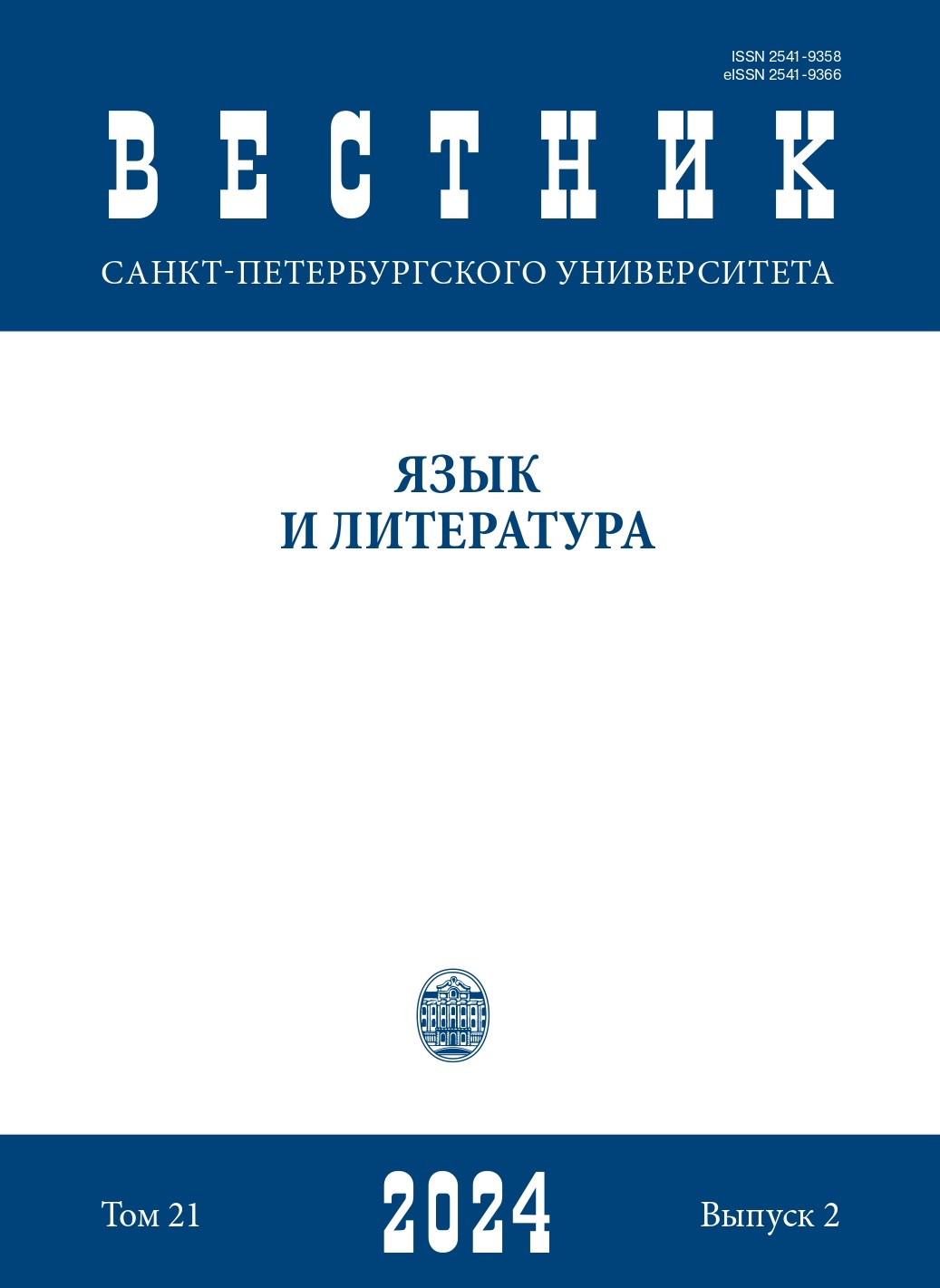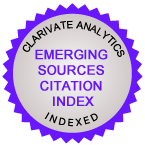Deviation from the directness of morality in the key conceptual metaphors of the 15th–17th centuries: From religion to philosophy (corpus and cognitive analysis)
DOI:
https://doi.org/10.21638/spbu09.2024.213Abstract
This paper explores the dynamics of how the conceptualizations of deviation from morally approved behaviour are verbalized through analysing the conceptual metaphor of deviation from straightness/straight line. The core metaphor for describing morality is a straight horizontal or vertical line, and violating morality can be represented by a deviation from it. However, the verbalization of the development of ideas about morality and moral responsibility on a rich historical material has not been previously analyzed linguistically. Two lexemes “pravity” and “obliquity” were chosen for the analysis; and their combinability, semantics, and metaphoricity were examined on the extensive corpus of the 15th–17th century texts including Google books and English Historical Book Collection (1758 contexts in total). Studying the transitional periods in discursive strategies of describing morality as well as the development of certain types of discourse is of paramount importance. The paper aims to show how religious discourse has influenced philosophical discourse, not only at the level of the issues discussed like morality, moral responsibility, and moral judgment, but also at the level of language. The specificity of our approach is the combination of corpus and cognitive linguistic methods, in particular the study of metaphor. The statistical analysis with the general linear model (GLM) was carried out to verify the proposals made and to identify the degree of correlation between the type of meaning realized in each context and the type of discourse. The results show ideological, discursive, metaphorical, and terminological continuity between religious and philosophical discourse.
Keywords:
morality, conceptual metaphor, corpus analysis, quantitative methods, philosophical and religious discourse
Downloads
References
Литература
Апресян* 2006 — Апресян Р. Г.* Этическая проблематика в «Опыте о человеческом разумении» Дж. Локка. Историко-философский ежегодник. М.: Наука, 2006. С. 132–152.
Бахтин 2000 — Бахтин М. М. Проблемы творчества Достоевского [1929]. В кн.: Бахтин М. М. Собрание сочинений. В 7 т. Т. 2: Проблемы творчества Достоевского. Статьи о Толстом. Записи курса лекций по истории русской литературы. М.: Русские словари, 2000. С. 5–175.
Болдырев 2010 — Болдырев Н. Н. Категориальный уровень представления знаний в языке: модусная категория отрицания. Когнитивные исследования языка. 2010, (7): 45–59.
Веккер 1998 — Веккер Л. М. Психика и реальность. Единая теория психических процессов. М.: Смысл, 1998.
Галиева, Нагуманова 2016 — Галиева А. М., Нагуманова Э. Ф. Метафора в философском тексте: оригинал и перевод. Филология и человек. 2016, (4): 39–50.
Горбатков 2008 — Горбатков А. А. Исследование позитивно-негативной асимметрии эмоций на разных уровнях субъектного развития. Психология. Журнал Высшей школы экономики. 2008, 5 (2): 133–143.
Захаров, Хохлова 2014 — Захаров В. П., Хохлова М. В. Выделение терминологических словосочетаний из специальных текстов на основе различных мер ассоциации. В сб.: Технологии информационного общества в науке, образовании и культуре: сб. науч. ст.: тр. XVII Всерос. объедин.конф. «Интернет и современное общество» (IMS-2014), Санкт-Петербург, 19–20 ноября 2014 г. СПб., 2014. С. 290–293.
Звада, Позняк 2016 — Звада О. В., Позняк Л. П. К вопросу языковых репрезентаций морального дискурса. Вестник Кемеровского государственного университета. 2016, (2): 176–181.
Лакофф 1990 — Лакофф Дж. Теория метафоры. М.: Прогресс, 1990.
Николаева 2002 — Николаева Т. М. «Скрытая память» языка: попытка постановки проблемы. Вопросы языкознания. 2002, (4): 25–41.
Соколов 2011 — Соколов П. В. Physica sacra Исаака Ньютона в контексте трактатов о «теории Земли»: препринт WP6/2011/02 [Текст]. Савельева И. М. (ред.). Сер.: Гуманитарные исследования. М.: Изд. дом Высшей школы экономики, 2011.
Шарапкова, Манерко 2022 — Шарапкова А. А., Манерко Л. А. Становление терминосистемы философии морали в трудах Дж. Локка: новаторство и дань традиции. Научный диалог. 2022, 11 (8): 92–120.
Campbell 1991 — Campbell D. T. A naturalistic theory of archaic moral orders. Zygon. 1991, 26 (1): 91–114. https://doi.org/10.1111/j.1467-9744.1991.tb00804.x
Cavarero 2016 — Cavarero A. Inclinations. Stanford: Stanford University Press, 2016. https://doi.org/10.1515/9781503600416
Denham 2000 — Denham A. E. Metaphor and moral experience. Oxford: Oxford University Press, 2000. https://doi.org/10.1093/acprof:oso/9780198240105.001.0001
Douglas 1966 — Douglas M. Purity and Danger: An Analysis of Concepts of purity and Taboo. London: Routlege & Kegan Paul, 1966.
Gentner, Bowdle 2001 — Gentner D., Bowdle B. F. Convention, Form, and Figurative Language Processing. Metaphor and Symbol. 2001, 16 (3): 223–247. https://doi.org/10.1207/S15327868MS1603&4_6
Harley 1993 — Harley D. N. Medical metaphors in English moral theology, 1560–1660. Journal of the history of medicine and allied sciences. 1993, 48 (4): 396–435. https://doi.org/10.1093/jhmas/48.4.396
Hill, Lewicki 2006 — Hill T., Lewicki P. Statistics methods and applications. StatSoft, Tulsa, OK. http://www.statsoft.com/textbook/stathome.html (дата обращения: 15.12.2023).
Johnson 1996 — Johnson M. How moral psychology changes moral theory. In: Mind and Morals: Essays on Cognitive Science and Ethics. May L., Friedman M., Clark A. (eds). Cambridge: MIT Press, 1996. P. 45–68. https://doi.org/10.7551/mitpress/4621.003.0007
Kövecses 2005 — Kövecses Z. A broad view of cognitive linguistics. Acta Linguistica Hungarica. 2006, 52 (2–3): 135–172. https://doi.org/10.1556/ALING.52.2005.2-3.2
Lakoff 1996 — Lakoff G. Moral politics. Chicago: University of Chicago Press, 1996.
Lakoff, Johnson 2008 — Lakoff G., Johnson M. Metaphors we live by. London: University of Chicago Press, 2008.
Lizardo 2012 — Lizardo O. The conceptual bases of metaphors of dirt and cleanliness in moral and nonmoral reasoning. Cognitive Linguistics. 2012, 23 (2): 367–393. http://doi.org/10.1515/cog-2012-0011
McCullagh 2019 — McCullagh P. Generalized linear models. Routledge, 2019.
Pacilli et al. 2018 — Pacilli M. G., Pagliaro S., Spaccatini F., Giovannelli I. Straight to heaven: Rectitude as spatial representation of morality. European Journal of Social Psychology. 2018, 48 (5): 663–672. https://doi.org/10.1002/ejsp.2358
Rimell 2017 — Rimell V. Philosophy’s Folds: Seneca, Cavarero, and the History of Rectitude. Hypatia. 2017, 32 (4): 768–783. https://doi.org/10.1111/hypa.12361
Rychlý 2008 — Rychlý P. A Lexicographer-Friendly Association Score. RASLAN. 2008: 6–9.
Sherry 1550 — Sherry R. A Treatise of Schemes & Tropes. London: J. Day, 1550. https://quod.lib.umich.edu/e/eebo/A12121.0001.001?view=toc (дата обращения: 22.04.2023).
Voorhees et al. 2018 — Voorhees B., Read D., Gabora L. The objectivity of moral norms is a top-down cultural construct. Behavioral and Brain Sciences. 2018, 41 (E116): 31–49. https://doi.org/10.1017/S0140525X18000213
White 1997 — White P. R. R. Death, Disruption and the Moral Order: The Narrative Impulse in Mass-Media ‘Hard News’ Reporting. In: Genres and Institutions: Social Processes in the Workplace and School. Christie F., Martin J. R. (eds). London: Cassell, 1997. P. 101–133.
Yu 2015 — Yu N. Metaphorical character of moral cognition: A comparative and decompositional analysis. Metaphor and Symbol. 2015, 30 (3): 163–183. https://doi.org/10.1080/10926488.2015.1049500
Yu et al. 2016 — Yu N., Wang T., He Y. Spatial Subsystem of Moral Metaphors: A Cognitive Semantic Study. Metaphor and Symbol. 2016, 31 (4): 195–211. https://doi.org/10.1080/10926488.2016.1223470
References
Апресян* 2006 — Apresian R. G.* Ethical Issues in J. Locke’s “Essay Concerning Human Understanding”. Istoriko-filosofskii ezhegodnik. Moscow: Nauka Publ., 2006. P. 132–152. (In Russian)
Бахтин 2000 — Bakhtin M. M. The problems of Dostoevsky’s works [1929]. In: Bakhtin M. M. Sobranie sochinenii. In 7 vols. Vol. 2: Рroblemy tvorchestva Dostoevskogo. Stat’i o Tolstom. Zapisi kursa lektsii po istorii russkoi literatury. Moscow: Russkie slovari Publ., 2000. P. 5–175. (In Russian)
Болдырев 2010 — Boldyrev N. N. Categorical level of knowledge representation in language: Modus category of negation. Kognitivnye issledovaniia iazyka. 2010, (7): 45–59. (In Russian)
Веккер 1998 — Vekker L. M. Psyche and reality. Unified theory of mental processes. Moscow: Smysl Publ., 1998. (In Russian)
Галиева, Нагуманова 2016 — Galieva A. M., Nagumanova E. F. Metaphor in a philosophical text: THe original and the translation. Filologiia i chelovek. 2016, (4): 39–50. (In Russian)
Горбатков 2008 — Gorbatkov A. A. The study of positive-negative asymmetry of emotions at different levels of subjective development. Psikhologiia. Zhurnal Vysshei shkoly ekonomiki. 2008, 5 (2): 133–143. (In Russian)
Захаров, Хохлова 2014 — Zakharov V. P., Khokhlova M. V. Selection of terminological phrases from special texts based on various measures of association. In: Tekhnologii informatsionnogo obshchestva v nauke, obrazovanii i kul’ture: sbornik nauchnykh statei: trudy XVII Vserossiiskoi ob”edinennoi konferentsii “Internet i sovremennoe obshchestvo” (IMS-2014), Sankt-Peterburg, 19–20 noiabria 2014 g. St. Petersburg, 2014. P. 290–293. http://ojs.itmo.ru/index.php/IMS/article/view/268/264 (accessed: 01.03.2022). (In Russian)
Звада, Позняк 2016 — Zvada O. V., Pozniak L. P. On the question of linguistic representations of moral discourse. Vestnik Kemerovskogo gosudarstvennogo universiteta. 2016, (2): 176–181. (In Russian)
Николаева 2002 — Nikolaeva T. M. “Hidden memory” of language: an attempt to pose the problem. Voprosy iazykoznaniia. 2002, (4): 25–41. (In Russian)
Лакофф 1990 — Lakoff G. Theory of metaphor. Мoscow: Progress Publ., 1990. (In Russian)
Соколов 2011 — Sokolov P. V. Isaac Newton’s Physica sacra in the context of Treatises on the “Theory of the Earth”: preprint WP6/2011/02 [Text]. Savel’eva I. M. (ed.). Ser.: Gumanitarnye issledovaniia. Moscow: Izdatel’skii dom Vysshei shkoly ekonomiki Publ., 2011. (In Russian)
Шарапкова, Манерко 2022 — Sharapkova A. A., Manerko L. A. The formation of the terminological system Baumeister et al. 2001 — Baumeister R. F., Bratslavsky E., Finkenauer C., Vohs K. D. Bad is stronger than good. Review of general psychology. 2001, 5 (4): 323–370. https://doi.org/10.1037/1089-2680.5.4.323
Campbell 1991 — Campbell D. T. A naturalistic theory of archaic moral orders. Zygon. 1991, 26 (1): 91–114. https://doi.org/10.1111/j.1467-9744.1991.tb00804.x
Cavarero 2016 — Cavarero A. Inclinations. Stanford: Stanford University Press, 2016. https://doi.org/10.1515/9781503600416
Denham 2000 — Denham A. E. Metaphor and moral experience. Oxford: Oxford University Press, 2000. https://doi.org/10.1093/acprof:oso/9780198240105.001.0001
Douglas 1966 — Douglas M. Purity and Danger: An Analysis of Concepts of purity and Taboo. London: Routlege & Kegan Paul, 1966.
Gentner, Bowdle 2001 — Gentner D., Bowdle B. F. Convention, Form, and Figurative Language Processing. Metaphor and Symbol. 2001, 16 (3): 223–247. https://doi.org/10.1207/S15327868MS1603&4_6
Harley 1993 — Harley D. N. Medical metaphors in English moral theology, 1560–1660. Journal of the history of medicine and allied sciences. 1993, 48 (4): 396–435. https://doi.org/10.1093/jhmas/48.4.396
Hill, Lewicki 2006 — Hill T., Lewicki P. Statistics methods and applications. StatSoft, Tulsa, OK. http://www.statsoft.com/textbook/stathome.html (дата обращения: 15.12.2023).
Johnson 1996 — Johnson M. How moral psychology changes moral theory. In: Mind and Morals: Essays on Cognitive Science and Ethics. May L., Friedman M., Clark A. (eds). Cambridge: MIT Press, 1996. P. 45–68. https://doi.org/10.7551/mitpress/4621.003.0007
Kövecses 2005 — Kövecses Z. A broad view of cognitive linguistics. Acta Linguistica Hungarica. 2006, 52 (2–3): 135–172. https://doi.org/10.1556/ALING.52.2005.2-3.2
Lakoff 1996 — Lakoff G. Moral politics. Chicago: University of Chicago Press, 1996.
Lakoff, Johnson 2008 — Lakoff G., Johnson M. Metaphors we live by. London: University of Chicago Press, 2008.
Lizardo 2012 — Lizardo O. The conceptual bases of metaphors of dirt and cleanliness in moral and nonmoral reasoning. Cognitive Linguistics. 2012, 23 (2): 367–393. http://doi.org/10.1515/cog-2012-0011
McCullagh 2019 — McCullagh P. Generalized linear models. Routledge, 2019.
Pacilli et al. 2018 — Pacilli M. G., Pagliaro S., Spaccatini F., Giovannelli I. Straight to heaven: Rectitude as spatial representation of morality. European Journal of Social Psychology. 2018, 48 (5): 663–672. https://doi.org/10.1002/ejsp.2358
Rimell 2017 — Rimell V. Philosophy’s Folds: Seneca, Cavarero, and the History of Rectitude. Hypatia. 2017, 32 (4): 768–783. https://doi.org/10.1111/hypa.12361
Rychlý 2008 — Rychlý P. A Lexicographer-Friendly Association Score. RASLAN. 2008: 6–9.
Sherry 1550 — Sherry R. A Treatise of Schemes & Tropes. London: J. Day, 1550. https://quod.lib.umich.edu/e/eebo/A12121.0001.001?view=toc (дата обращения: 22.04.2023).
Voorhees et al. 2018 — Voorhees B., Read D., Gabora L. The objectivity of moral norms is a top-down cultural construct. Behavioral and Brain Sciences. 2018, 41 (E116): 31–49. https://doi.org/10.1017/S0140525X18000213
White 1997 — White P. R. R. Death, Disruption and the Moral Order: The Narrative Impulse in Mass-Media ‘Hard News’ Reporting. In: Genres and Institutions: Social Processes in the Workplace and School. Christie F., Martin J. R. (eds). London: Cassell, 1997. P. 101–133.
Yu 2015 — Yu N. Metaphorical character of moral cognition: A comparative and decompositional analysis. Metaphor and Symbol. 2015, 30 (3): 163–183. https://doi.org/10.1080/10926488.2015.1049500
Yu et al. 2016 — Yu N., Wang T., He Y. Spatial Subsystem of Moral Metaphors: A Cognitive Semantic Study. Metaphor and Symbol. 2016, 31 (4): 195–211. https://doi.org/10.1080/10926488.2016.1223470
Downloads
Published
How to Cite
Issue
Section
License
Articles of "Vestnik of Saint Petersburg University. Language and Literature" are open access distributed under the terms of the License Agreement with Saint Petersburg State University, which permits to the authors unrestricted distribution and self-archiving free of charge.






